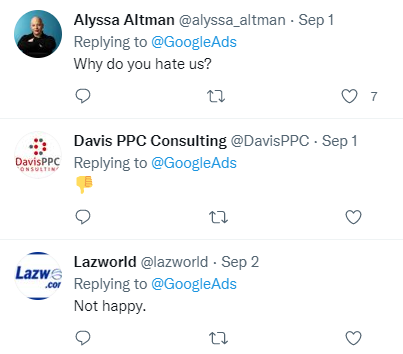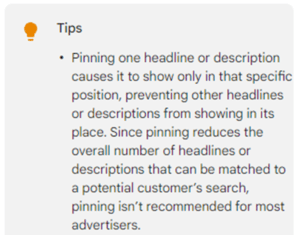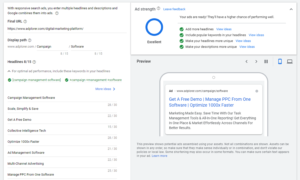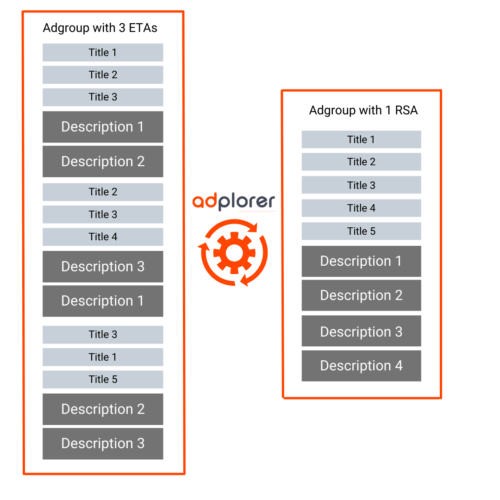In March 2021, Google replaced expanded text ads (ETAs) with responsive ads (RSAs) as the standard ad type. By doing this, it was clear that the ETA ad format would no longer be supported in the long run. In fact, Google has since officially announced that it will phase out this ad type on June 30, 2022. After that date, no new ads (ETAs) can be created and no changes can be made to existing ads (ETAs). In the meantime, here are some answers to common questions about this ad format:
1. How and when will Google remove ETAs?
Official guidance on responsive ads are:
- After June 30, 2022, you will no longer be able to create or edit expanded text ads.
- But they will continue to be disseminated and the associated performance reports will also be available.
- If necessary, you can pause and resume your enlarged text ads as usual or delete them.
2. Why is Google deleting ETAs?
Google justifies this change on its own blog as follows:
Every year, there are billions of search queries on Google. 15% of the search queries that arrive each day are new. This means that these search queries have never been made before. This means that presenting users with the right answers to questions is a bigger challenge every day.
In our opinion, they participate in more bids because of their multiple combinations and tailoring to the user’s search query, so the ad group gets better performance with more clicks and more frequent conversions.
3. What are the reactions?
Most of the reactions to these Google ads on Twitter were pretty negative:

One reason for these reactions could be that advertisers value the control they have with ETAs and now fear losing that control to Google with RSAs.
=> If you look closely, Google does not directly control full text. It is possible to unintentionally distort the context of the post with the change of order in the ads.
Until now, campaign managers and advertisers were perfectly fine with the usual three headlines and two descriptions. Now, a total of 15 headlines combined with up to 4 descriptions are possible; this seems very daunting at first glance, just because of the amount of content required.
Advertising creative that cannot be directly controlled can pose a significant danger in formally regulated organizations. In banks, for example, with regard to designations within their precisely defined regions or franchise systems with predefined ad templates that cannot be changed.
4. Are there any solutions currently available?
Suggestion #1: put pins everywhere.
On Twitter, I saw a workaround: “You can easily create exactly three titles and two descriptions in RSAs and pin them.”

My take on this:
A smart solution. On the face of it. But it ruins the purpose of RSAs and I wouldn’t be surprised if Google blocked the ability to use pins at some point. We assume, after all, that Google would prefer to decide for itself when to display which text. But currently that would work.
Suggestion #2: Define a few fields, leave the rest blank.
Fill in only three titles and two descriptions and leave the rest of the RSA blank as an ETA. But in my opinion, Google will impact the quality level (Quality Score) of your ads and therefore the ranking of the ads will be negatively affected. The performance of the ads will be weakened.
5. The new reports
You have the ability to get performance data for your overall responsive ad in the same way you did for ETAs. By viewing the details of the ad elements, you will be able to see the number of impressions for each title and description. Performance data is not available for each actual ad. With up to 15 headlines and 4 descriptions, and thousands of possible combinations, a detailed report on each individual ad served would theoretically be possible, but not very meaningful. However, you do have access to the number of impressions for each combination.
6. The reasons for the shift from ETAs to RSAs:
A. Google’s enhanced automation
David, project manager at Adplorer:
“The influence of a text ad cannot be overstated. In this fast-paced age, the most important thing is that the ad is displayed to the right user in the right context. The text modules must then convince the user within milliseconds that the content of the web page could be relevant for him. Of course, the ad must be error-free, creative and tailored to the company’s identity, but at best, the user will skim the text. Rarely does anyone pay more attention to a text ad. What position of elements is most effective in the context of that search query, Google will be better able to decide with automation. “
B. This is a consistent continuation of ETA
David continued:
“However, you need to make sure that each title and description stands alone and can stand on its own. Phrases that span multiple fields are no longer recommended.”
C. Stay in control
Pinning individual items is currently still mentioned by Google itself as an option:

D. Time factor
There are still several months to go before we can no longer create enlarged text ads. ETAs already established can be evaluated and used with the previous instruments.
The result is the following recommendations for action:
- Continue to create and test ETAs.
- Implement these tips for successful RSAs
- Call announcements are always supported.
7. Adplorer’s Advice
A. Continue to create and test ETAs
Yes, these ads will continue to run. But will not be able to be changed after the deadline. Continue to do A/B testing and use ETAs. But allow less time to create ads, set the right priority: Spend less time improving ETA ads, pay more attention to targeting control in PPC campaigns. Targeting is much more important, a long thought out change in the headline in an expanded text ad does not determine whether an ad works or fails.
B. Tips for successful RSAs:
- Updating the advertising text regularly generates new and interesting content for the recipient of the advertising message.
- Keyword slots create individuality and topicality, ad extensions create more opportunities for interaction.
- Use Google’s ad preview.
- Look for consistent advertising combinations so that all combinations can work together successfully.
- Pinning the elements still allows control.

C. The call announcements are always taken care of!
Local service providers often have the campaign goal of receiving calls. Google, offers call ads, a perfect format for these advertisers.</spa,>
D. Ask Adplorer’s help to transform in bulk all your ETAs to RSAs
If you want to transform all your ETAs into RSAs to avoid any problems and increase your performance, we can help you with that. We will use existing titles and descriptions of ETAs to create new RSAs. If you have 3 ads per ad group, we are going to gather your 9 titles, delete the duplicates, do the same with the 6 descriptions and use the remaining titles and descriptions to create one or two RSAs depending on the number of titles and descriptions we have.
Now is an important time to update your clients’ accounts because starting in July, you will no longer be allowed to modify ETAs. From then on, every time a client asks to make a change to an ad, you will have to manually create an RSA and delete the existing ETA. We know RSAs get better results than ETAs, especially when it comes to CTR, and your clients deserve to realize those improved results.

Conclusion
At first glance, expanded text ads offer more control options than responsive search ads. However, in our opinion, RSAs are a natural and logical progression that has advantages, especially for creating relevant and powerful ads. Once set up, a variety of different ads can be created simultaneously. In addition, advertisers who use ETAs as a template can gradually transition to RSAs. Platform providers such as Adplorer can support the uniform and systematic conversion of large quantities of existing ETAs to RSAs with their software. At the same time, clear reports offer options for monitoring campaign performance and draw attention to possible adjustment levers for improving ad performance.

